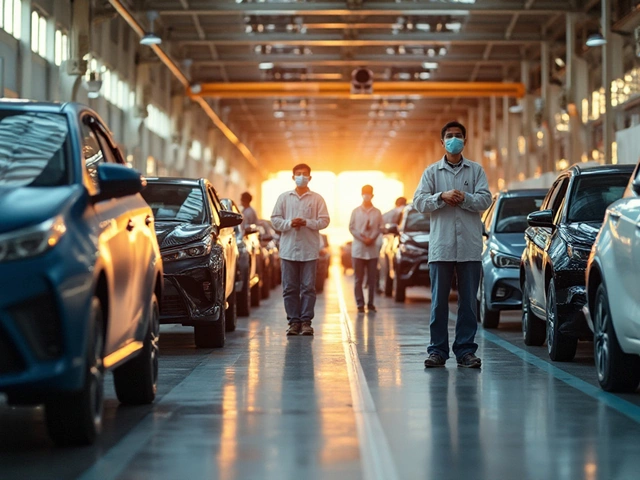Diesel engines have long powered a significant portion of India's transportation sector, renowned for their fuel efficiency and torque capabilities. However, recent years have witnessed a notable shift as restrictions have been placed on these engines in favor of environmental preservation and technological advancement.
This article explores the motivations behind such actions, highlighting the balance between economic interests and ecological responsibilities. By understanding these changes, stakeholders in the automobile industry can better navigate this evolving landscape, contributing to a cleaner and more sustainable future.
- Historical Context of Diesel Engines in India
- Reasons Behind the Ban
- Impact on Automobile Industry
- Alternatives to Diesel Engines
- Government Policies and Regulations
- Future of Automobile Engines in India
Historical Context of Diesel Engines in India
The journey of diesel engines in India is both storied and significant, tracing back to the days when the country started to industrialize and modernize its infrastructural backbone. The post-independence era marked an acceleration in adopting diesel engines due to their robust performance and fuel efficiency, particularly important in a developing nation striving to stretch every resource. In the 1950s and 60s, India's burgeoning economy saw the introduction of diesel-powered commercial vehicles as they became the backbone of transportation for goods and public transit. This reliance on such engines wasn't just an economic choice but a practical one, considering the need for vehicles capable of traveling long distances over varied terrain with minimal refueling stops.
As the years progressed, the 1980s and 90s witnessed a surge in foreign collaborations and technological exchanges, bringing more advanced diesel technology to Indian shores. Automakers like Tata, Mahindra, and later, global giants such as Ford and Toyota, pushed the envelope by producing diesel engines that were more refined and user-friendly. A notable period was the late 2000s, when rising fuel prices globally leaned manufacturers and consumers alike towards diesel cars, perceived as more economical for the common man. Diesel engines powered not only trucks and buses but also passenger cars, tractors, and even small-scale industrial machinery, firmly embedding themselves into the nation's socio-economic fabric.
According to a 2017 report by the Ministry of Petroleum and Natural Gas, diesel consumption alone accounted for about 40% of the country's total fuel usage, highlighting its pivotal role in the energy landscape of India.
This widespread adoption was not without its challenges. The emissions from diesel engines became a growing concern, with urban centers like Delhi and Mumbai often witnessing alarming levels of air pollution. As awareness increased alongside the demand for cleaner technologies, the push toward reducing diesel engines' environmental impact gathered momentum. Regulatory norms began tightening, and standards—such as Bharat Stage legislation—were introduced to curb emissions. The pressure to innovate became increasingly urgent as public health impacts and international environmental commitments necessitated a re-evaluation of diesel's role in India's mobility sector.
Amid this backdrop, the dynamics surrounding diesel engines continue to evolve, marked by shifts towards greener alternatives. However, their historical significance remains undeniable, forming the bedrock upon which the contemporary Indian automotive industry was built. The narrative of diesel in India is one of adaptation, resilience, and transformation, reflecting the country's rapid advancement in the face of complex challenges.
Reasons Behind the Ban
The decision to place restrictions on diesel engines in India comes from a blend of environmental, health, and regulatory motivations. First and foremost, the detrimental impact of diesel engines on air quality cannot be ignored. Diesel-powered vehicles are notable for emitting higher levels of nitrogen oxides (NOx) and particulate matter, both of which contribute significantly to air pollution. In bustling cities like Delhi, already grappling with some of the worst air quality levels globally, these emissions exacerbate smog and pose serious health risks to the populace.
Scientific studies have linked diesel engine emissions to respiratory issues, heart disease, and even cancer. The Indian government, prompted by both domestic and international pressures, recognized the urgent need to act. According to the World Health Organization, exposure to outdoor air pollution is estimated to cause millions of premature deaths annually, a statistic that drives home the necessity of cutting down diesel emissions. Thus, the decision to ban older and more polluting diesel engines can be seen as a public health intervention.
"The transition towards cleaner alternatives is not just a policy issue but a moral imperative," noted an environmental expert in a Times of India interview, highlighting the social responsibility aspect in curbing harmful emissions.
Besides public health concerns, climate change is a crucial factor in this equation. Diesel engines, while often championed for their efficiency, still release significant amounts of carbon dioxide, a key greenhouse gas. In line with global efforts to tackle climate change, India has pledged to reduce its carbon footprint, and moving away from diesel engines forms a part of this commitment. Fostering the adoption of electric and hybrid vehicles aligns with India's goal to electrify its vehicle fleet.
The emergence of more stringent regulatory standards also plays a pivotal role. Bharat Stage VI norms, equivalent to the Euro 6 standards followed in Europe, set drastic emission limits that many older diesel engines simply cannot meet. These norms aim to slash levels of pollutants from vehicles significantly, compelling manufacturers to innovate or phase out outdated technologies. This regulatory landscape not only encourages the sustainability of the automobile sector but also drives technological advancements.
Consumer behavior and market dynamics shouldn't be overlooked either. As awareness about environmental impacts grows, consumers are gradually favoring eco-friendly alternatives. The demand for cars powered by clean energy is on the rise, and manufacturers are keen to cater to this growing segment. The shift away from diesel not only aligns with environmental policies but also reflects a response to evolving consumer preferences.
However, it's worth noting that this transition isn't without its challenges. India’s automotive industry has been historically reliant on diesel engines, and moving away from them involves significant economic and infrastructure hurdles. But the long-term benefits, in terms of public health improvement and environmental sustainability, are deemed to outweigh the short-term disruptions.

Impact on Automobile Industry
The ban on older diesel engines in India has stirred significant waves within the automobile industry, reshaping strategies and prompting a reevaluation of long-term plans. Companies that relied heavily on the manufacture and sale of diesel-powered vehicles have found themselves at a crossroads, needing to adapt to this new regulatory environment. This adaptation process, both challenging and rewarding, has called for a change in production lines, investment in research and development for cleaner technologies, and a shift in marketing landscapes. While diesel's grip on the market diminishes, the demand for alternative engines rises, creating a novel set of dynamics.
The impact reaches beyond economic considerations, sparking an innovative spirit among manufacturers. Stringent rules have incentivized companies to invest more heavily in emerging technologies such as electric and hybrid engines. This technological transformation, albeit daunting, has put India on the map as a potential leader in the industry. Additionally, it sparks competition among domestic and international brands to capture the expanding market of environmentally-conscious consumers. The government’s tilt toward sustainability is not solely a challenge but a considerable opportunity for brands aiming to tap into this fresh, eco-friendly market.
The market is also witnessing shifts in consumer perception. Diesel, often chosen for its robustness and economics, began to lose its glamour with rising fuel prices and ecological awareness. Consumers are now more inclined to support sustainable technology, not only because of regulatory pressures but also due to growing environmental awareness. This changing sentiment is influencing purchasing decisions, thereby challenging manufacturers to meet these new demands effectively. Companies such as Tata Motors and Mahindra & Mahindra are investing significantly in greener technologies to maintain a competitive edge in this evolving landscape.
Moreover, the regulation poses an unquestionable financial impact. Automotive companies have had to adjust their supply chains, increase importations of new parts, or invest in the development of cleaner technologies. This, in turn, affects their pricing strategies, potentially impinging on profit margins. However, with risks come opportunities, and businesses are finding innovative pathways to balance these investments against anticipated long-term returns. Amidst these operational challenges, the industry remains optimistic. As Nitin Gokhale, a prominent industry analyst, noted,
"The restrictions on diesel engines, though initially disruptive, could very well be the catalyst that pushes India's automobile industry towards a sustainable and technologically advanced future."
Interestingly, smaller startups have also seized this shift as an avenue to introduce themselves into a market hungry for innovation. These nimble businesses can navigate changes with more agility than their larger counterparts, often acting as invaluable partners for established firms seeking to diversify. The intricate web of partnerships, vertical integrations, and mergers continues to redefine the playing field, suggesting a landscape of dynamic growth for those nimble enough to capitalize on it.
The ripple effect extends overseas as well, influencing the dynamics of international trade. India, a key market for many global brands, brings changes to their business strategies in how vehicles are designed, engineered, and marketed not only domestically but also worldwide. As diesel engines gradually fade from the limelight, a new chapter dawns upon the global automobile industry influenced by these regional policies. Indeed, this proves a fascinating period of implementation, adjustment, and significant breakthroughs for automakers striving to align with eco-friendly policies while upholding their commitment to quality and reliability.
Alternatives to Diesel Engines
The world of automobile manufacturing is undergoing an extensive transformation as industries seek viable substitutes for traditional diesel engines. This shift is particularly evident in India, where legislative changes and heightened environmental consciousness have pushed manufacturers to diversify their options. One of the most prominent alternatives being explored is the electric vehicle. Driven by a growing network of charging infrastructure and significant advancements in battery technology, electric vehicles have rapidly become a favorite among both new car buyers and manufacturers.
Electric cars, while still a burgeoning industry in terms of widespread adoption, offer several advantages over diesel-powered counterparts. The absence of tailpipe emissions and the reduction in greenhouse gases make them a key player in combating air pollution. In recent years, electric car sales in India have seen a substantial uptick, fueled by both government incentives and private investment. Additionally, the technology itself has evolved with rapid innovation making electric vehicles more accessible and cost-effective than ever before. It’s a shared vision not just held by entrepreneurs but supported by influential figures who see electrification as the future. As noted by Elon Musk in an interview, "The acceleration of sustainable transport is crucial for our future."
Another contender in the race to replace diesel engines is the hybrid vehicle. Hybrids use a combination of a traditional internal combustion engine and an electric motor to improve fuel efficiency and reduce emissions. They serve as a bridge for consumers transitioning away from fossil fuels without the range anxiety associated with fully electric vehicles. This dual system provides a pragmatic pathway for drivers who are cautious about relying solely on electric charging infrastructure, which is still developing in many regions. Hybrid vehicles have been praised for their smooth integration of new and conventional technologies, offering an attractive balance of performance and efficiency.
Compressed Natural Gas (CNG) is another alternative gaining traction, especially for public transportation and commercial vehicles. CNG offers a cleaner combustion process compared to diesel, resulting in fewer nitrogen oxides and particulate emissions. The existing network of CNG stations in many urban centers has made the switch a practical proposition for fleet operators. Bus services in large Indian cities have transitioned to CNG-powered systems, showcasing a commitment to cleaner urban transport solutions. Although infrastructure for CNG needs considerable expansion to meet broader adoption, its immediate benefits for air quality are tangible.
Hydrogen Fuel Cells represent an exciting frontier in alternative engine technology. These cells convert hydrogen gas into electricity, emitting only water vapor as a byproduct. With the potential to power vehicles with zero emissions, fuel cell technology is seen as a long-term solution for sustainable transportation. While still in the nascent stages in India, several pilot projects highlight the potential of hydrogen as part of a future diversified energy portfolio. However, challenges such as safe storage, infrastructure development, and cost reduction need resolution before fuel cells can compete widely.
As India sets its sights on cleaner alternatives, the commitment to innovation underscores a dynamic approach to transportation. This marks an exciting time for the country’s automobile industry, where opportunities to lead global trends coexist with challenges that demand ingenuity and resilience. The embrace of electric, hybrid, and alternative fuels illustrates a broad spectrum of choices seeking to meet the diverse needs of Indian consumers and contribute to a healthier planet.

Government Policies and Regulations
India's government has been at the forefront of efforts to combat air pollution and its harmful impacts on health and the environment. The restrictions on diesel engines have been primarily driven by these concerns, leading to a series of regulations aimed at reducing emissions. A key milestone was the implementation of the Bharat Stage VI (BS-VI) emission standards, which came into effect in April 2020. These stringent norms are on par with Euro VI standards and emphasize reducing nitrogen oxides (NOx) and particulate matter (PM), pollutants commonly associated with diesel engines.
The switch to BS-VI standards was no small feat. It demanded significant advancements in technology from manufacturers to comply with the reduced limits on emissions. For instance, diesel engines required the integration of selective catalytic reduction (SCR) technology and diesel particulate filters (DPF) to meet the standards. This not only increased the cost of production but also posed challenges in terms of design and engineering, making compliance a challenging task for many automobile manufacturers.
In addition to emission standards, certain cities in India, like Delhi, have taken radical measures to curb pollution levels by imposing an outright ban on diesel vehicles older than ten years. This move saw a significant reduction in the number of diesel-powered vehicles on the road and underscored the local government's commitment to cleaner air. The National Green Tribunal (NGT) has been vocal in its support for such measures, pushing for similar actions across the country. A pivotal ruling stated, "The emissions from diesel vehicles are carcinogenic and more noxious than petrol vehicles, thus demanding urgent regulatory attention."
Subsidies and incentives have also been introduced to encourage the shift towards more eco-friendly alternatives. The Faster Adoption and Manufacturing of Hybrid and Electric Vehicles (FAME) scheme is designed to promote electric vehicles (EVs) and hybrid vehicles by offering financial incentives to buyers and manufacturers. The Indian government has set ambitious targets under this scheme to establish a robust EV ecosystem by extending support to infrastructure development, such as charging stations, to make electric vehicles a viable option for a significant portion of the population.
The impact of these regulations extends beyond urban areas to include rural parts of India, where diesel has traditionally been the fuel of choice for farm equipment and other heavy machinery. While the transition has been gradual, policies continue to evolve to achieve a smoother shift to cleaner energy solutions. The government's dedication is reflected in the mounting investment in public transport systems powered by electricity and compressed natural gas (CNG), highlighting a commitment to sustainable progress.
As India charts a future focused on sustainability, the intersection of policy, innovation, and environment-friendly practices remains crucial. Balancing industry interests with environmental imperatives requires continued collaboration across sectors. With an evolving regulatory landscape, constant adaptation and fostering innovation will remain at the heart of advancing India’s vision for a greener future.
Future of Automobile Engines in India
The automotive landscape in India is on the cusp of transformation, with diesel engines gradually giving way to more environmentally-friendly alternatives. The future of automobile engines in India is being shaped by a variety of factors, including government regulations, technological advancements, and consumer preferences, all of which are driving the shift towards cleaner energy sources.
As the country seeks ways to reduce its carbon footprint and tackle air pollution, initiatives encouraging the adoption of electric and hybrid vehicles are gaining momentum. The Indian government has set ambitious targets to transition towards electric vehicles, aiming for a significant portion of the new vehicle sales to be electric in the next decade. This push is supported by policies such as subsidies, tax breaks, and the development of necessary infrastructure like charging stations. As a result, automakers are heavily investing in research and development to produce efficient and affordable electric models that cater to the diverse needs of Indian consumers.
"The transformation underway in India's automobile sector is nothing short of a revolution, driving us towards a future that prioritizes sustainability," remarks Anand Mahindra, chairman of Mahindra Group, a leading name in the country's automotive industry.
In addition to electric vehicles, hybrid engines, which combine internal combustion and electric power, are also gaining popularity. They offer a practical bridge during this transitional phase, providing reduced emissions without entirely forsaking the convenience of traditional engines. The interest in hybrid technology reflects a broader global trend where consumers value flexibility, especially in regions where electric infrastructure is still developing.
Renewable and alternative fuels are another key area of exploration. Companies are experimenting with biofuels and hydrogen fuel cells, exploring their potential as viable options for mass-market vehicles. These innovations are not only poised to redefine engine manufacturing but also align with national objectives of fostering energy independence and reducing reliance on fossil fuels.
Market analysts anticipate that as battery technology continues to improve, the price gap between electric and conventional vehicles will narrow, accelerating the shift. Battery costs, once a significant barrier to the widespread adoption of electric vehicles, are gradually decreasing, making these vehicles more accessible to the average consumer. This evolution is expected to introduce exciting opportunities and challenges for local manufacturers and international brands, who are eager to capture this growing market.
The competitive landscape is reshaping rapidly, with both legacy automakers and new entrants positioning themselves to capitalize on this paradigm shift. It's a race fueled by innovation, strategic partnerships, and an unwavering commitment to sustainability. As India continues on this journey, the future of automobile engines promises to be dynamic, challenging, and filled with potential to redefine mobility not just within the nation, but across the globe.







Write a comment